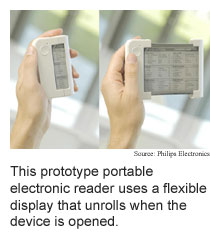
Week
of September 5, 2005
21st
century scrolls
If you were wondering what a device with a flexible display might
look like, you no longer have to wonder. Philips Electronics has built
a concept portable electronic wireless reader that demonstrates one possibility.
Readius is 3.9 inches by 2.4
inches by 0.8 inches and has narrow vertical display in compact mode and
a 5-inch, 320-by-240-pixel display when the flexible display scrolls out.

The display uses Philips' previously developed electronic paper
that uses polymer electronics and E Ink Corporation's electronic ink.
Phillips showed off the reader at the Internationale Funkausstellung
(IFA) consumer electronics exhibition held in Berlin, Germany September
2 to 7, 2005. The company also
demoed a 42-inch three-dimensional liquid crystal display, a digital
television receiver for handheld devices, an image processing system that
highlights the path of a soccer ball on a real-time television broadcast,
and illuminated pillows and floor mats made with light emitting diodes
embedded in cloth substrates.
Hierarchies promise better searches
Google's tremendous success arguably boils down to the company's
PageRank algorithm, which calculates the relative importance of web pages
and makes their Web search engine particularly effective. Researchers
from Microsoft Research Asia, Hong Kong University of Science and Technology
and Shanghai Jiao-Tong University in China have developed an alternative
algorithm that performs better than PageRank in laboratory tests.
The researchers' Hierarchical
Rank algorithm exploits the hierarchical structure of the Web. The
algorithm first looks at relative importance at the domain and organizational
level, for example stanford.edu and cs.stanford.edu, then at the relative
importance of pages within those units. PageRank and other algorithms
only look at page-to-page relationships. Hierarchical Rank allows pages
to inherit some of the importance of the sites they occupy, which overcomes
the difficulty new pages have in attaining visibility in search results,
according to the researchers.
(Exploiting the Hierarchical Structure for Link Analysis, Special
Interest Group Information Retrieval 2005 (SIGIR '05), August 15 to 19,
2005, Salvador, Brazil)
Store and forward qubits
Widespread use of quantum cryptography and other quantum communications
techniques requires that qubits -- quantum particles like photons that
are capable of storing information -- be sent over long distances, which
in turn requires the ability to store qubits. Quantum cryptography uses
the properties of photons to provide theoretically perfectly secure communications.
Qubits can be transmitted via photons and stored in atoms. Fading
photons can transfer information to atoms at intermediate points along
a network; those atoms can then generate new photons to carry the qubits
over the next leg of their journey. The problem is that the wavelengths
of light useful for transferring qubits to atoms is different from the
wavelengths of light useful for transmitting qubits over optical fibers.
Researchers from the University of Geneva in Switzerland and the
University of Nice-Sophia Antipolis in France have developed a technique
for transferring qubits between photons of different wavelengths. The
researchers demonstrated transferring qubits between photons with wavelengths
of 1,310 nanometers, which is a common telecommunications wavelength,
and photons with wavelengths of 710 nanometers, which is close to the
wavelength absorbed and emitted by the alkaline atoms used for qubit storage.
(A Photonic Quantum Information Interface, Nature, September
1, 2005)
Sonic needles
Soundwaves have the power to move matter, and not just by generating
unpleasant auditory sensations that clear people from a room. Researchers
have been able to focus and shape soundwaves and use them to move small
particles. Using this technique researchers have made virtual
test tubes using sound.
Researchers from Nanyang Technological University in Singapore
have taken the technique a
step further by using ultrasound traps to hold particles in place
and ultrasound virtual needles to spin the particles. The researchers
can control the revolution speed, and were able to rotate seeds as fast
as 300 revolutions per minute.
The technique could eventually be used to drive pumps and mixers
in microfluidic devices including labs-on-a-chip.
(Controlled Rotation of Sound-Trapped Small Particles by an Acoustic
Needle, Applied Physics Letters, August 29, 2005)
RSS Feeds: News Blog Books New: TRN's Internet Services TRN's Jobs Center News: Research News Roundup Research Watch blog Features: View from the High Ground Q&A How It Works Buy an ad link |
|
| Advertisements: |
|
Ad links: Clear History
Buy an ad link
|
TRN
Newswire and Headline Feeds for Web sites
|